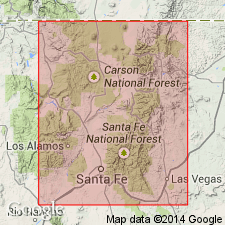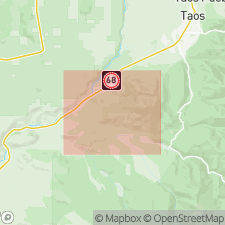
- Usage in publication:
-
- Piedra Lumbre Formation
- Modifications:
-
- Principal reference
- AAPG geologic province:
-
- Southern Rocky Mountain region
Summary:
Pg. 46 (table 1). Piedra Lumbre Formation of Hondo Group. Recognized in the Picuris Mountains of central northern New Mexico. Is top formation of Hondo Group, above the Pilar Formation. Age is considered Early Proterozoic, younger than 1,700 Ma.
Principal reference section (Hondo Group): Hondo Canyon area, in secs. 29 and 32, T. 24 N., R. 12 E., Taos SW 7.5-min quadrangle, Taos Co., northern Picuris Mountains, [Carson National Forest area], central northern NM.
Source: Publication.

- Usage in publication:
-
- Piedra Lumbre Formation
- Modifications:
-
- Age modified
- Geochronologic dating
- AAPG geologic province:
-
- Southern Rocky Mountain region
Summary:
Pg. 1424-1425, 1427, 1429 (fig. 5); C.G. Daniel and others, 2013, GSA Field Guide 33, p. 205-235. Piedra Lumbre Formation of Hondo Group. Schist and quartzite characterized by cm-scale graded beds and cm- to m-scale cross-bedded quartzite layers that become more abundant and thicker toward top of exposed section. Uppermost part consists of a 20 to 25 m-thick cross-bedded quartzite and black phyllite. Estimated maximum thickness of formation 400 m. Unconformably underlies Marquenas Formation; contact interpreted to be a ductile shear zone. Gradationally overlies Pilar Formation. New detrital zircon ages indicate deposition of Piedra Lumbre sediments occurred between ca. 1,490 Ma and 1,450 Ma (Mesoproterozoic).
[On p. 1429 (fig. 5), and p. 1432-1433, authors included the Piedra Lumbre and Pilar Formations in their informal Trampas group.]
Source: Publication.
For more information, please contact Nancy Stamm, Geologic Names Committee Secretary.
Asterisk (*) indicates published by U.S. Geological Survey authors.
"No current usage" (†) implies that a name has been abandoned or has fallen into disuse. Former usage and, if known, replacement name given in parentheses ( ).
Slash (/) indicates name conflicts with nomenclatural guidelines (CSN, 1933; ACSN, 1961, 1970; NACSN, 1983, 2005, 2021). May be explained within brackets ([ ]).

